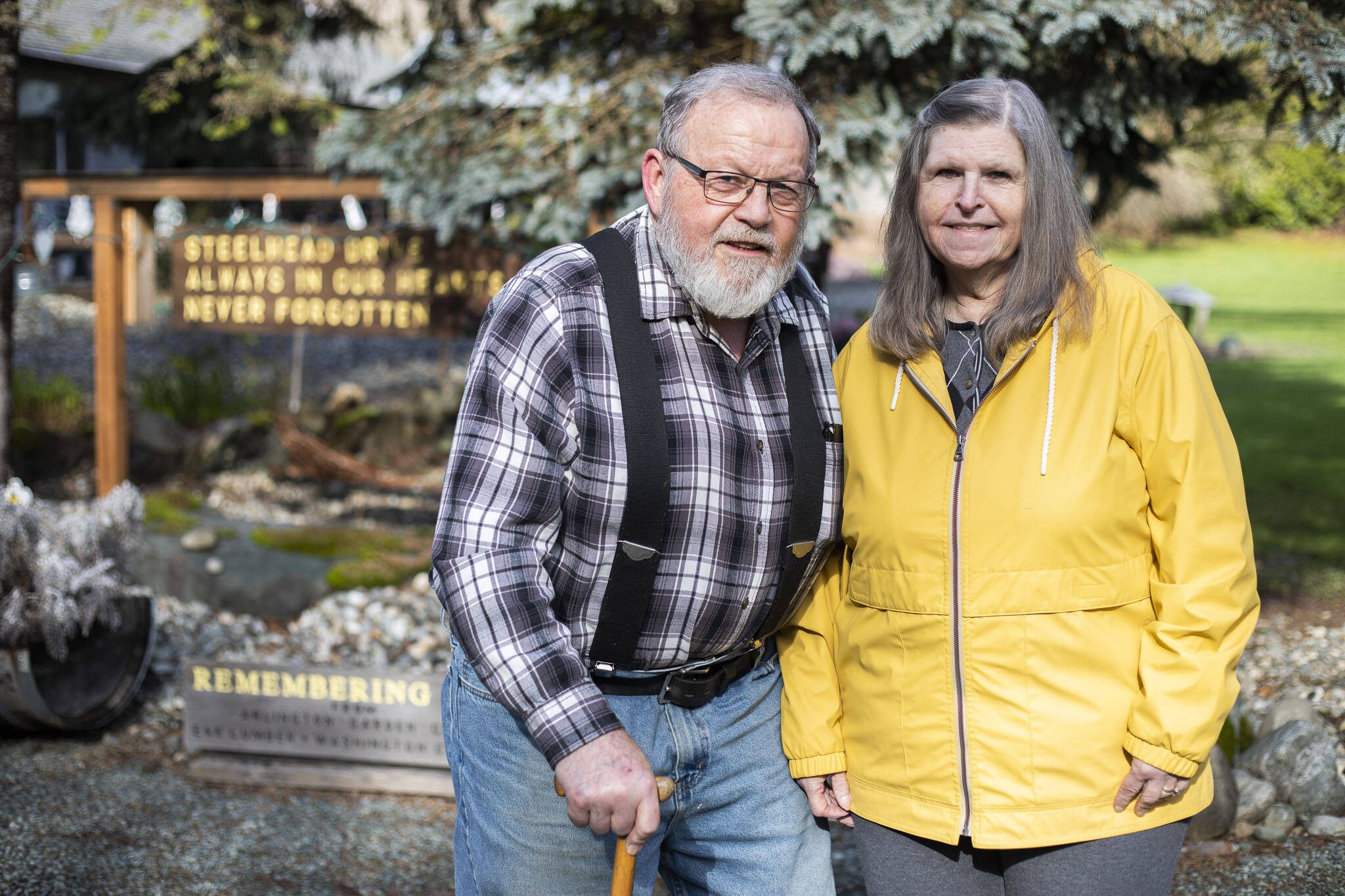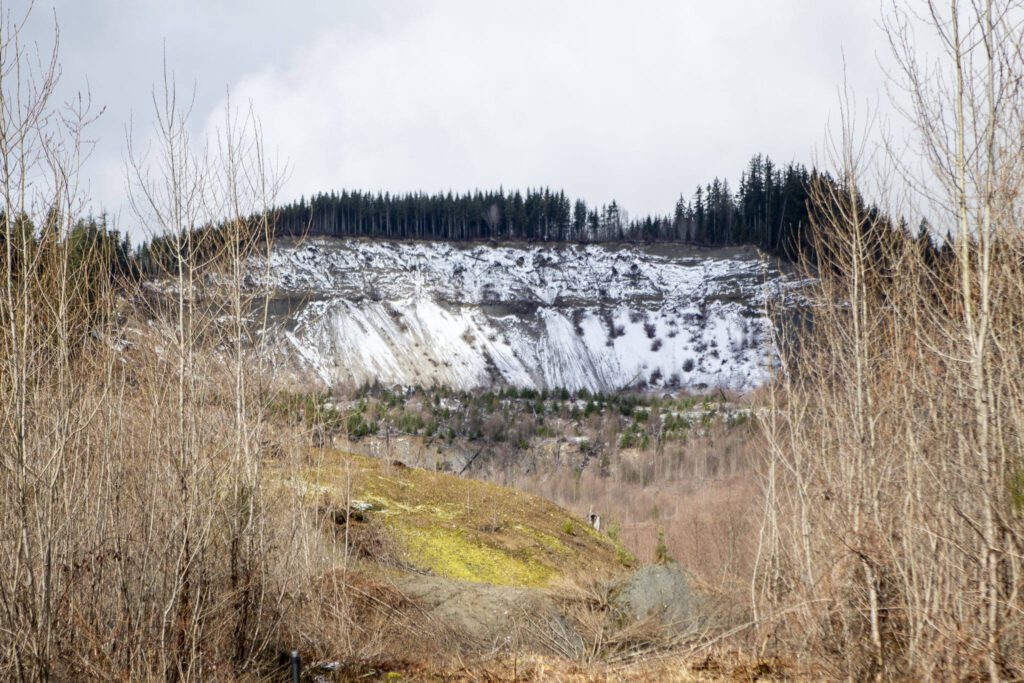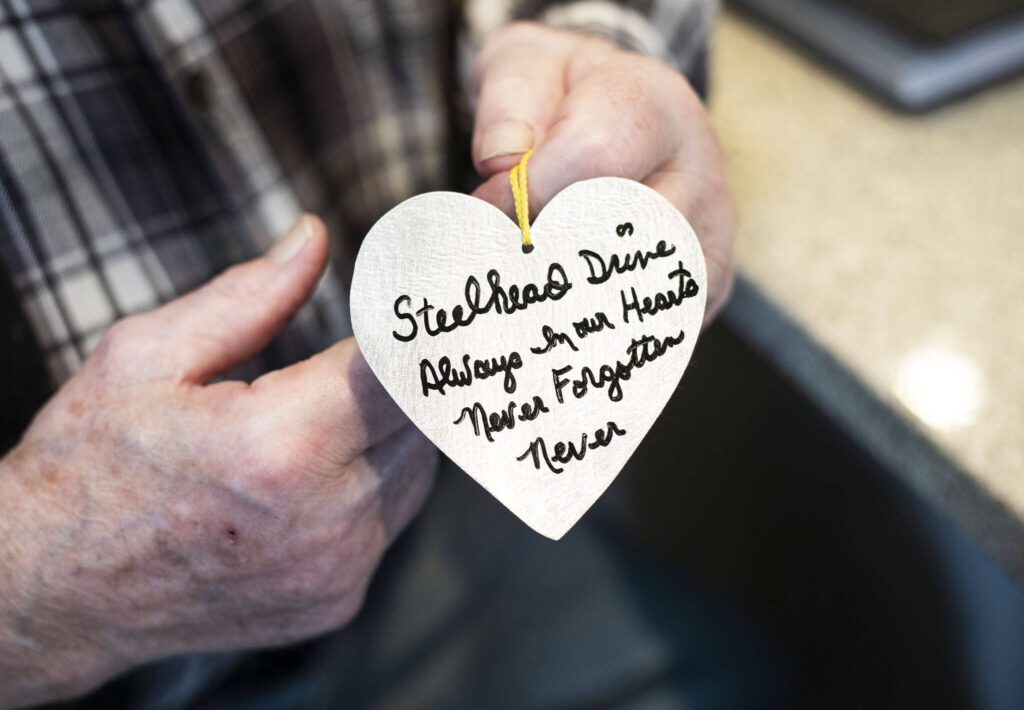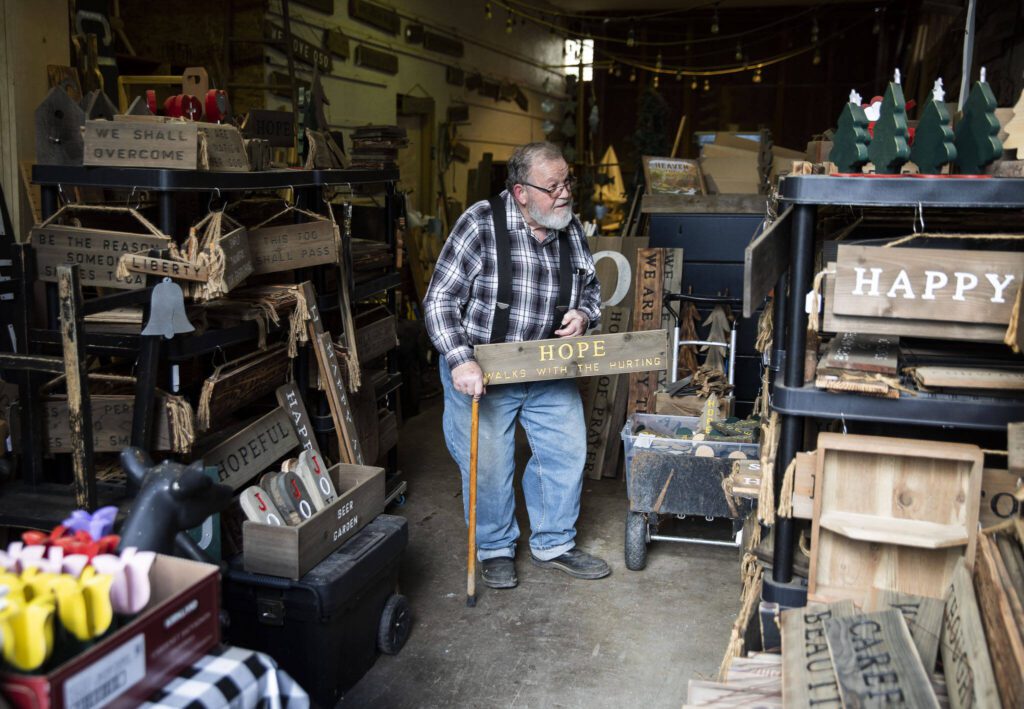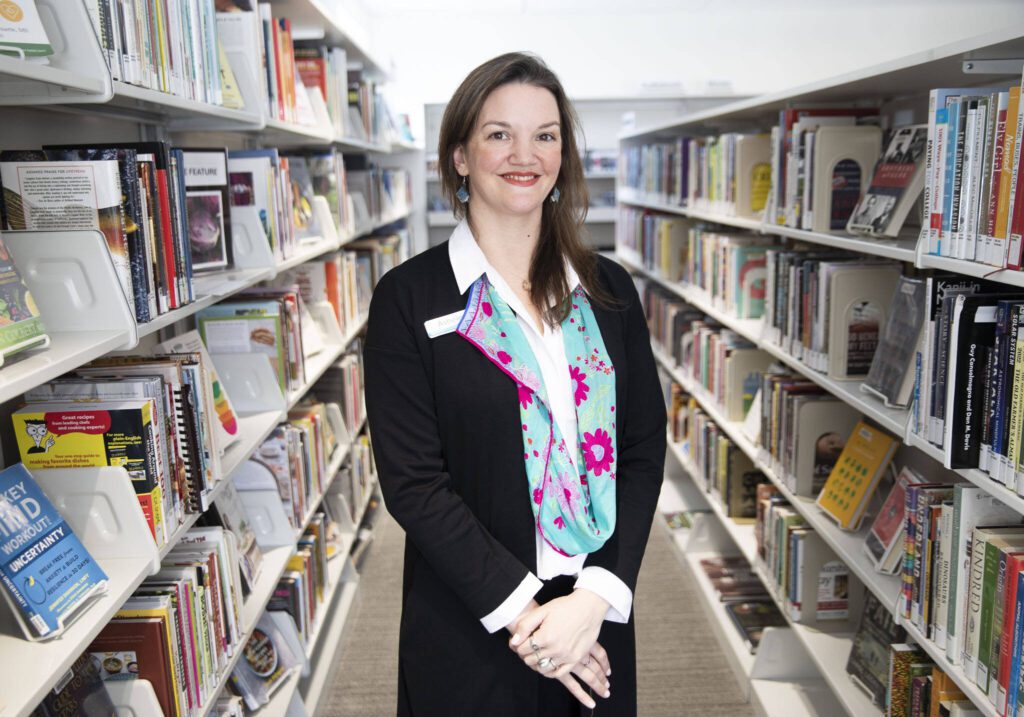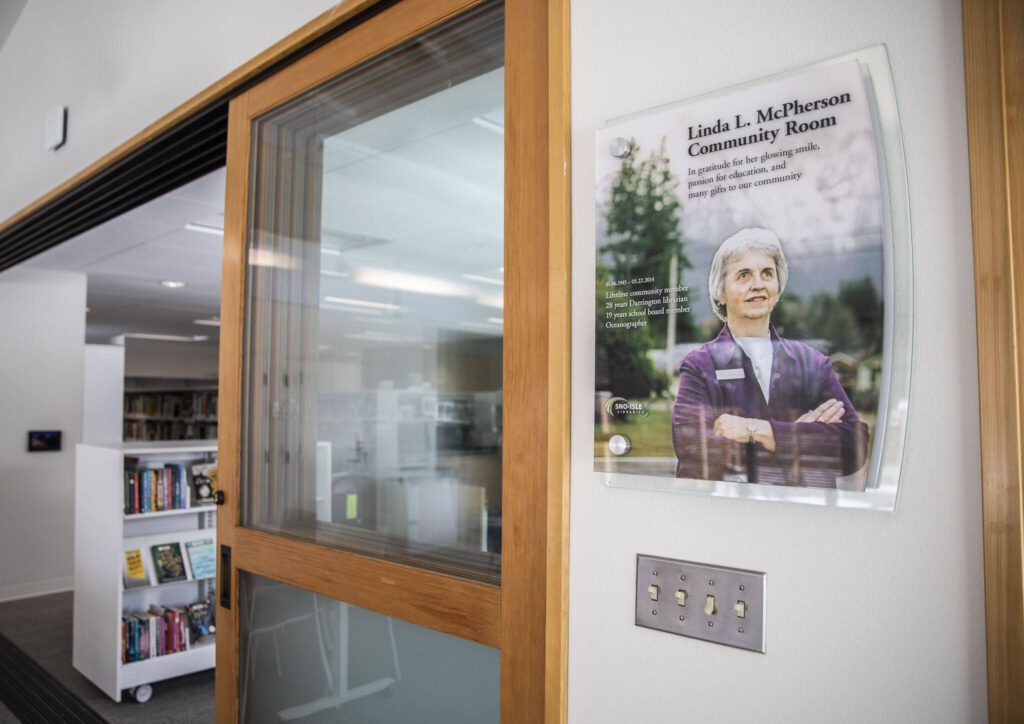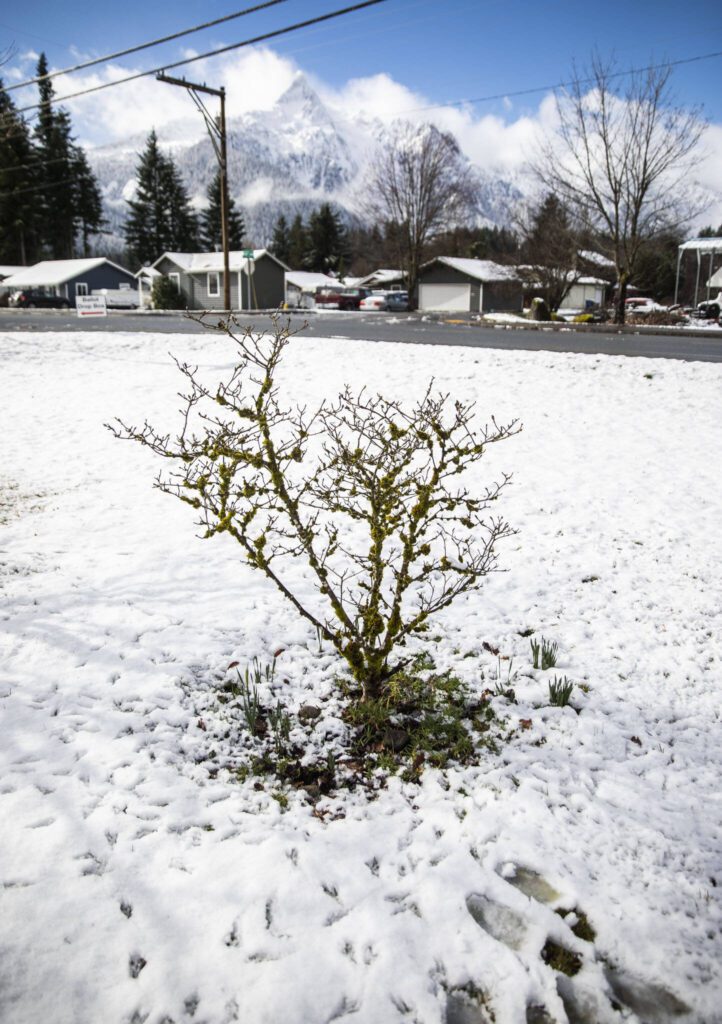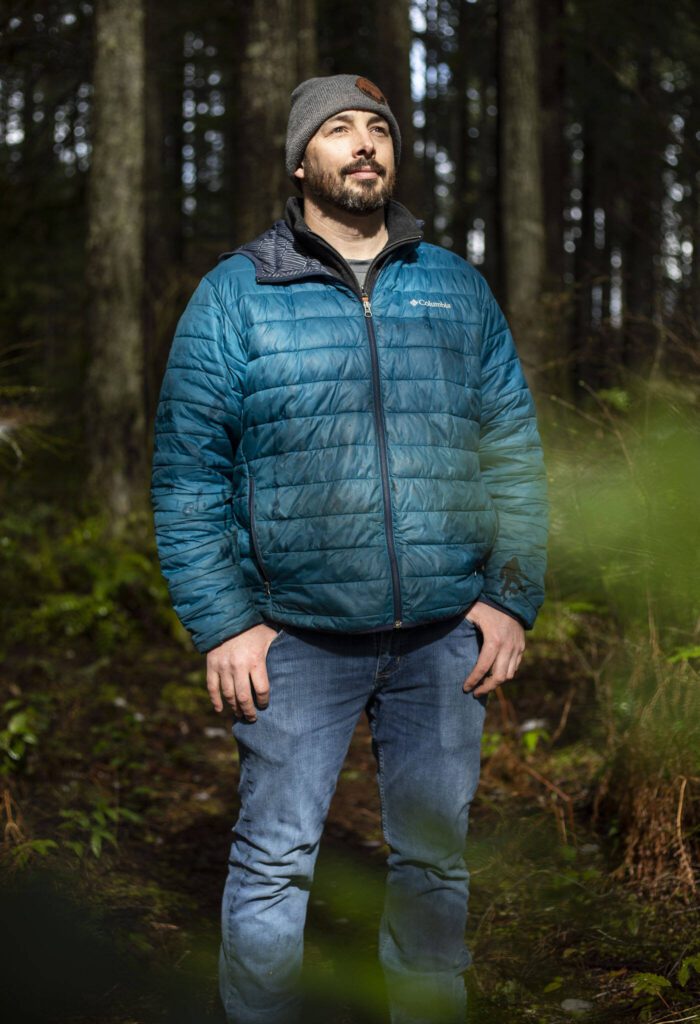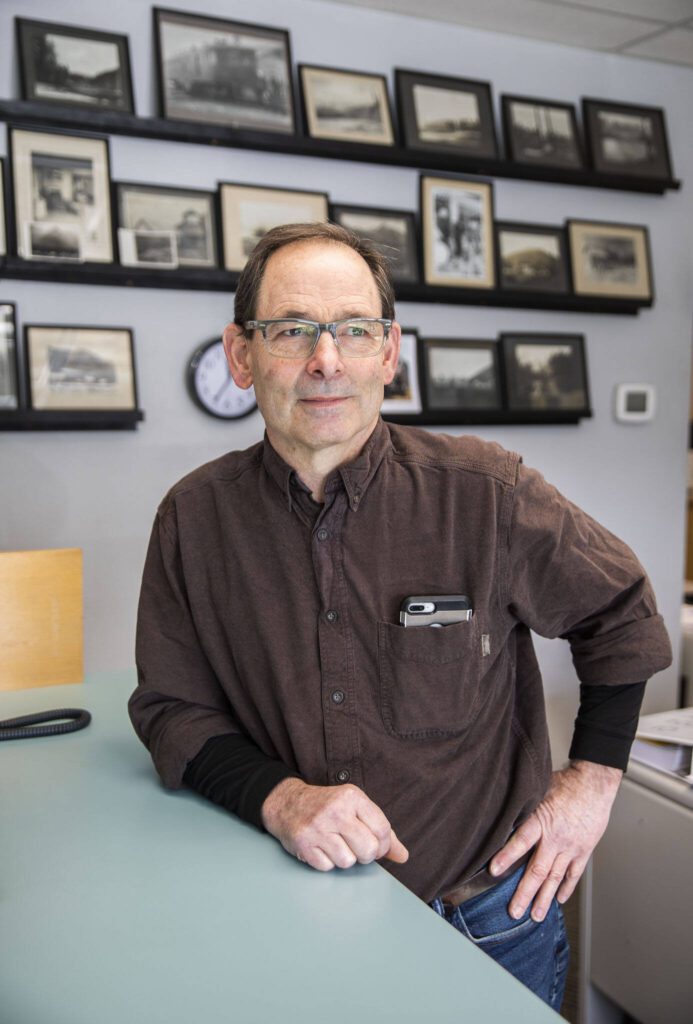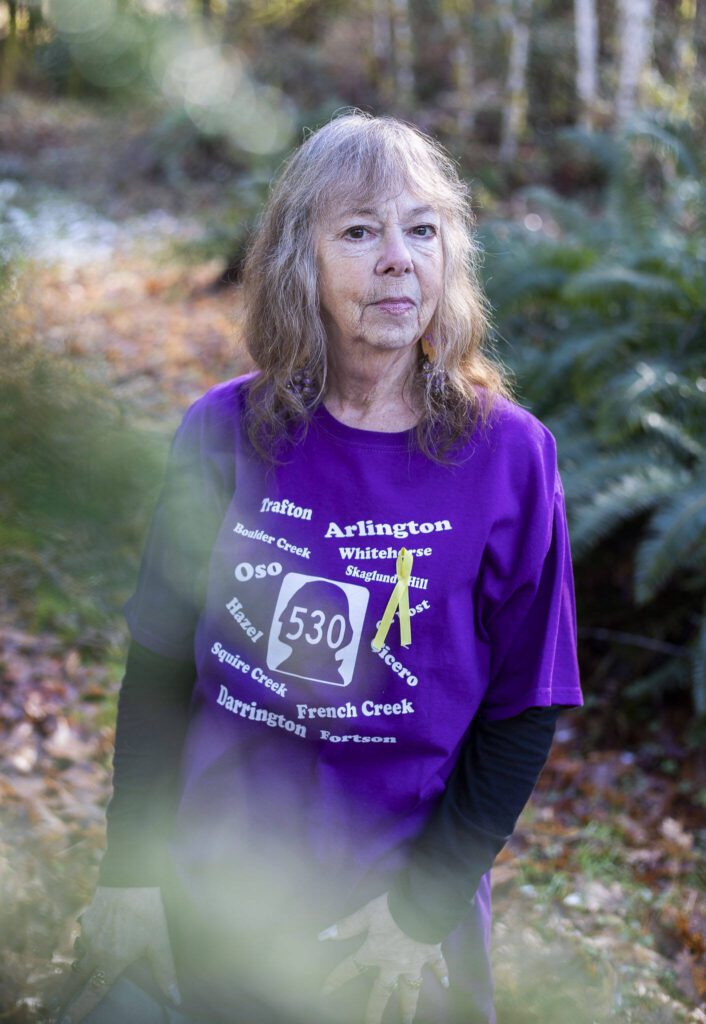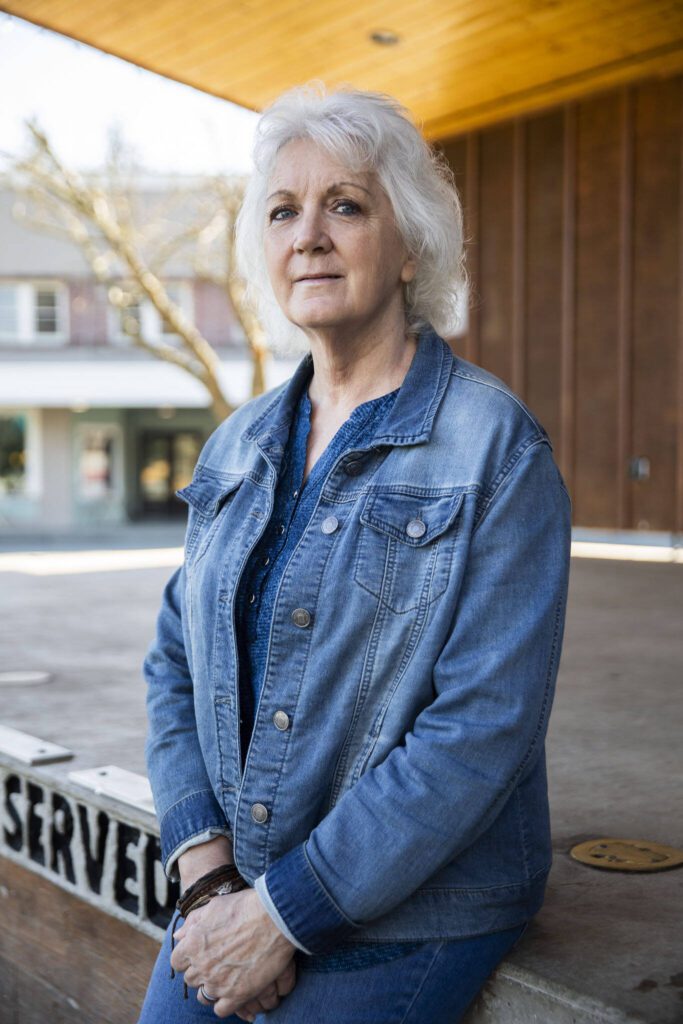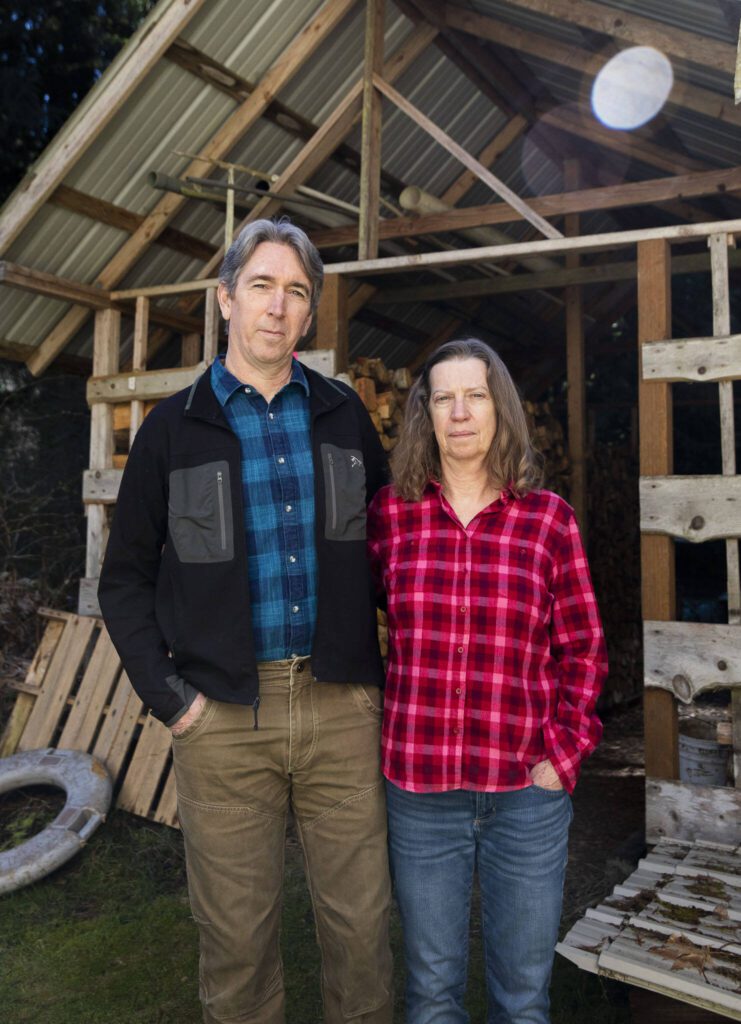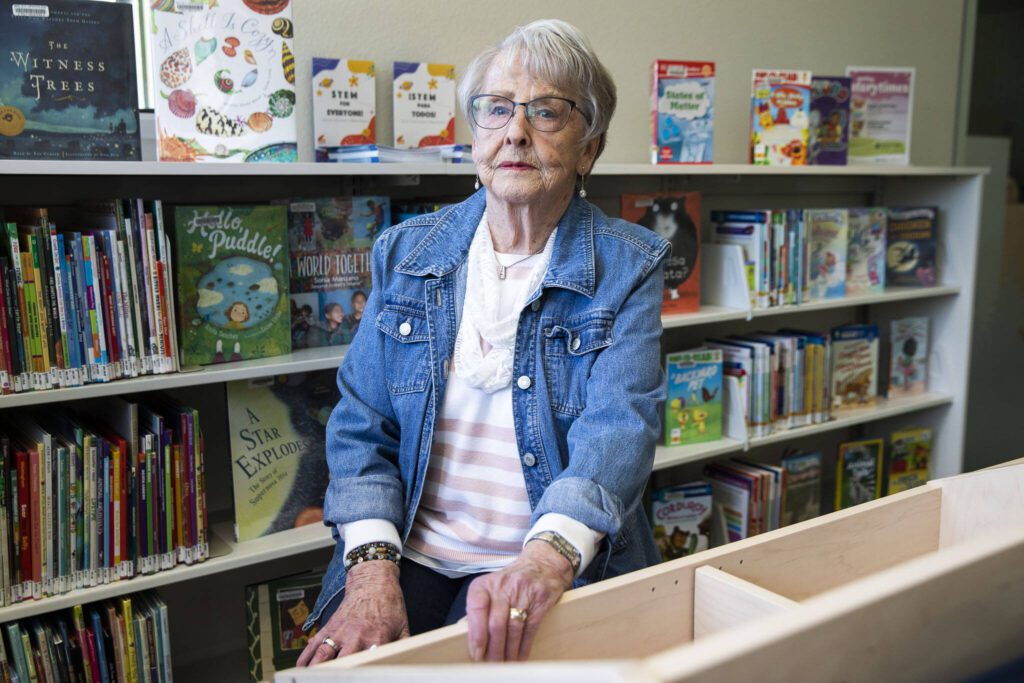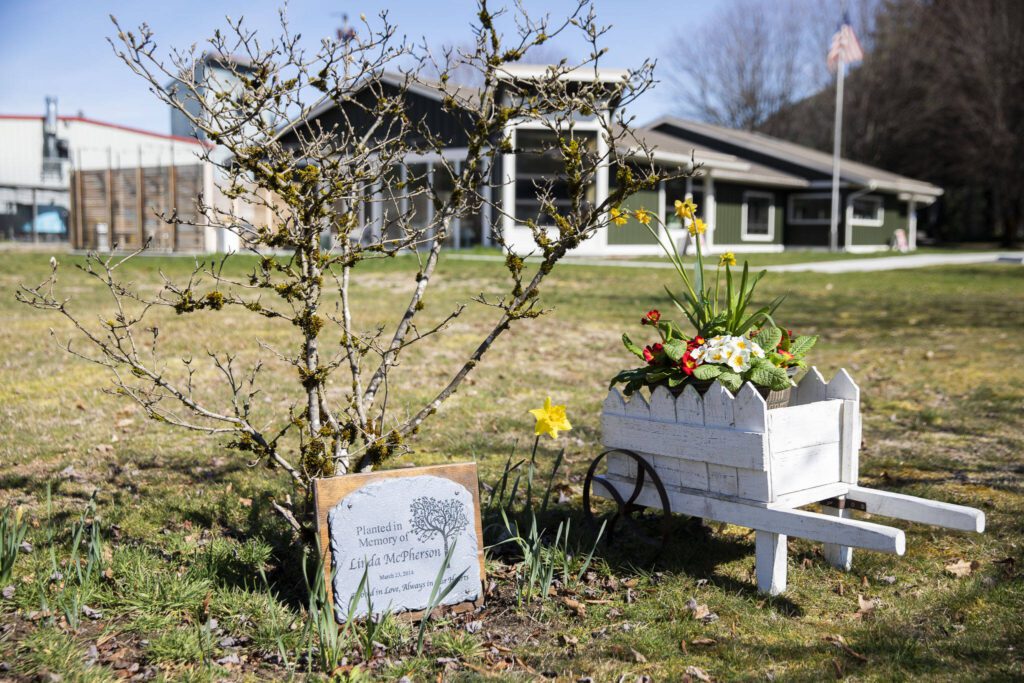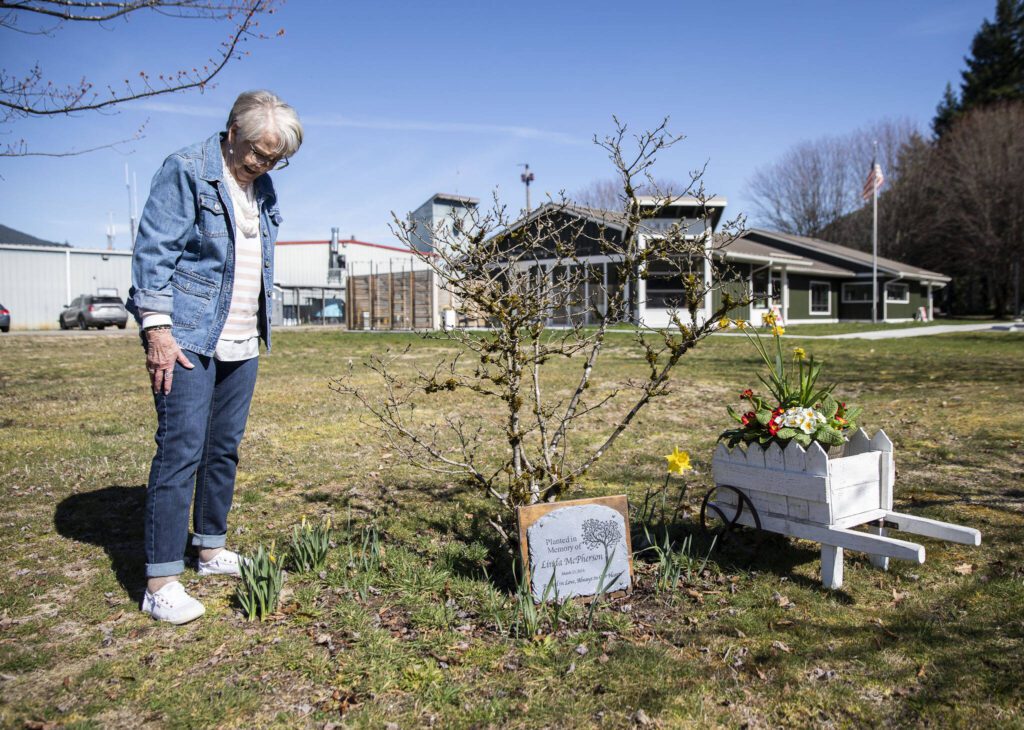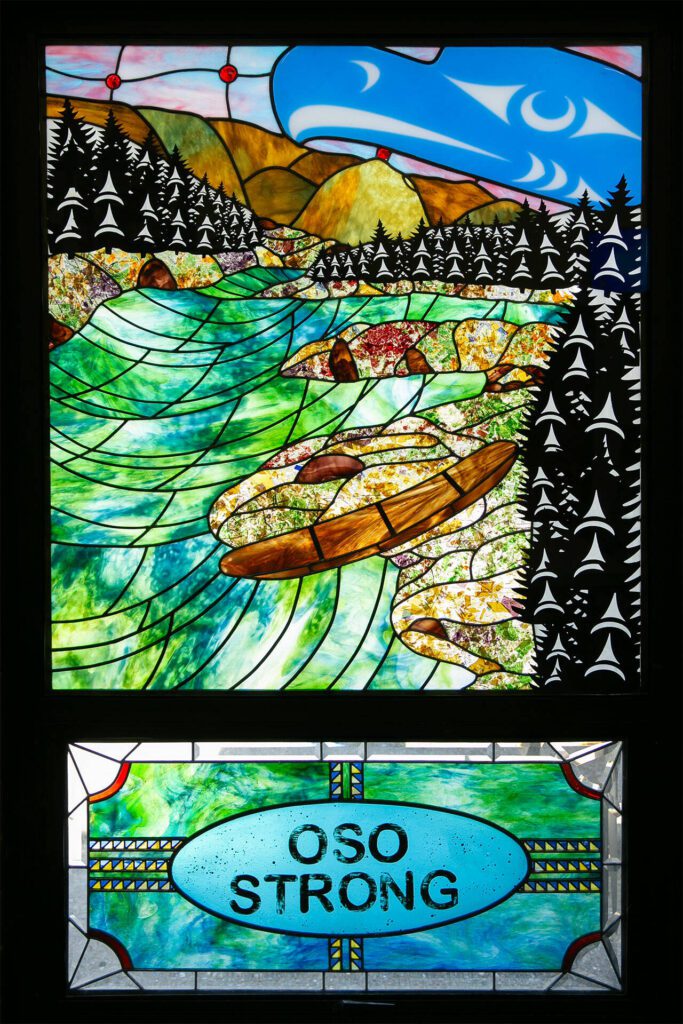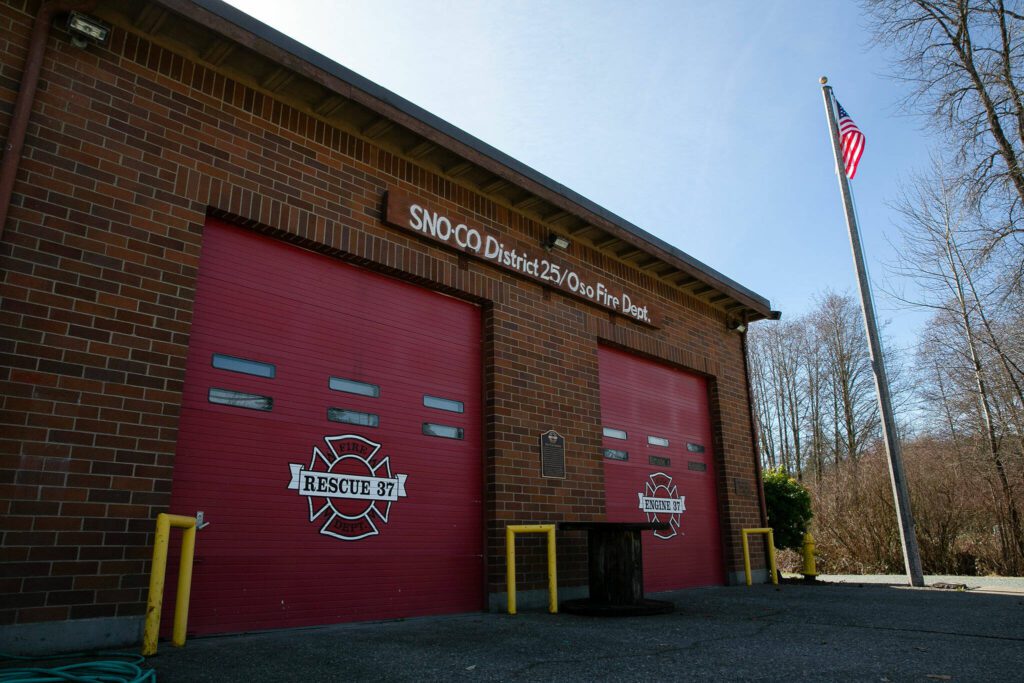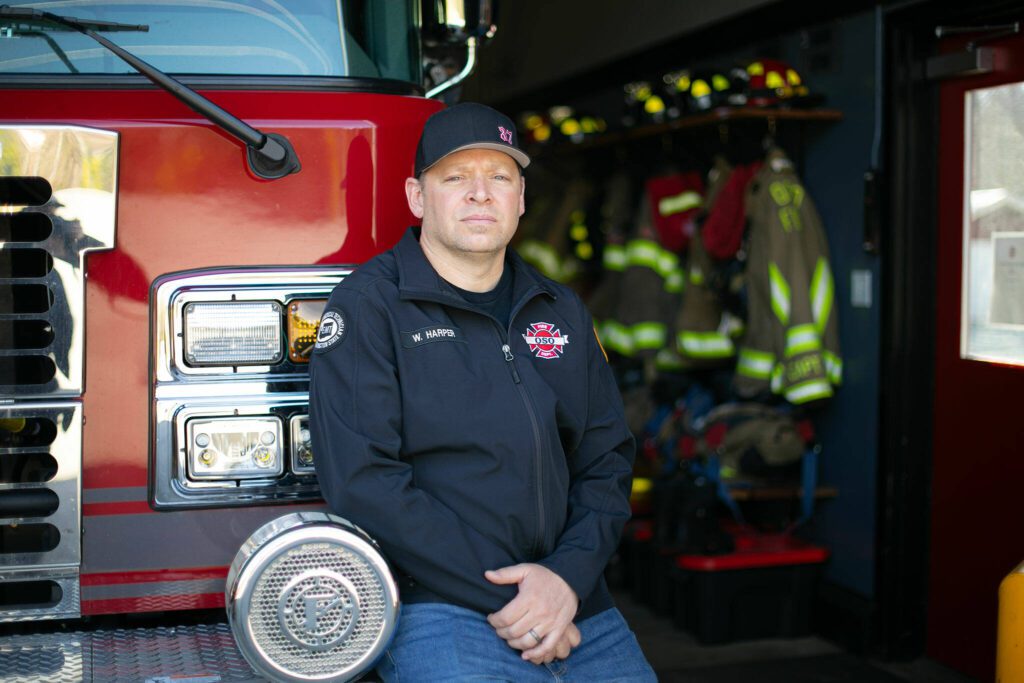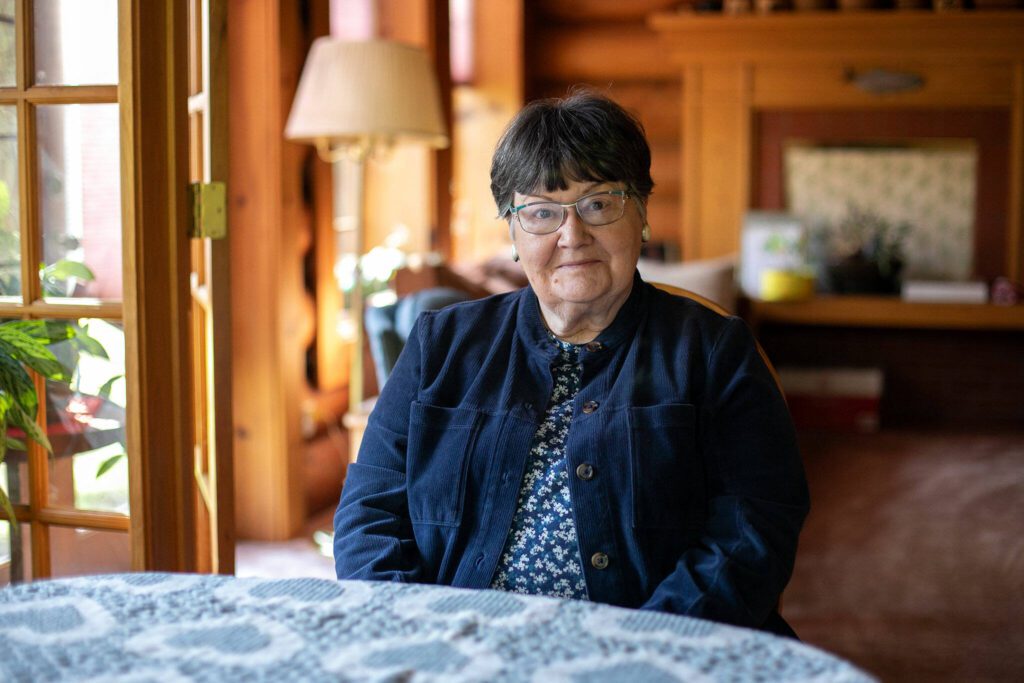OSO — Bare ground doesn’t last long in Western Washington.
Erika Morris knows. She has spent more than 20 years working for the U.S. Forest Service in Darrington.
She remembers saying, in the early days after the landslide alongside Highway 530: “I wonder how long it’ll take before we can’t even see this?”
A decade ago, on March 22, 2014, a piece of a hillside broke loose and tore through a quiet community in the Stillaguamish River valley. About 19 million tons of earth surged forward at the speed of a moving car. Eyewitnesses compared the thunderous roar to a plane crash. In about 60 seconds, the Steelhead Haven neighborhood was buried.
Forty-three people died. Survivors lost family and homes. Two towns — Oso to the west, Darrington to the east — were left to grapple with the aftermath.
In Erika Morris’ memory, a “green fuzz” of new growth appeared quickly. Today, trees partially obscure the view from the highway. Tourists often tell her they thought the slide zone would be bigger.
But there’s still a slice carved out of the mountain. For many, the scar on the landscape is a constant reminder of loss.
This year, with the unveiling of a long-awaited memorial, the anniversary looms particularly large.
“Some days it feels like it’s been 10 years,” Willy Harper, Oso’s fire chief since 2012, told a crowd six months after the slide, “and other days, 10 minutes.”
In the lead-up to the anniversary, locals reflected on living with grief and finding meaning after catastrophe.
‘What I saw was plenty’
The day of the slide, Harper ventured into the mud to help rescue Amanda Skorjanc and 5-month-old Duke Suddarth.
Every day after, Harper was based in Oso’s fire station coordinating volunteers and various agencies. For weeks, he would go home around midnight, then wake up at 2 a.m. to go back to the station.
“I didn’t experience as much as some of the other volunteers and my friends had to see,” he said. “And I know that what I saw was plenty.”
When soldiers go to war, Harper said, they’re at least prepared for what they might face. But after the slide, volunteers on both sides of the slide found themselves on the front lines of a massive rescue and recovery effort.
At first, they had to defy orders from officials to do so, determined to bring victims home.
Going into the mud was “nothing like you can ever imagine,” said John Hadaway, one of the volunteers.
“It was like a movie set,” he said. “When you first go out and you see the devastation and everything else that your eyes are seeing, nothing registers in your brain as it being real.”
Hadaway’s brother, Steven, was killed in the slide installing a satellite dish on one of the houses that was destroyed.
Marla Skaglund’s house, just west of the slide, became a base of operations for the rescue effort. First responders held meetings on her patio. People would go through her property for a lookout spot with the best view of the disaster zone. Donations poured in: food for humans and pets, clothes, gloves, reflective gear, shovels and more. People brought them to Skaglund’s house, because she was right there. She took the supplies to tents set up on the road, where they’d leave them for whoever needed them.
Every so often, a hush would fall over the scene. Equipment stopped. People stood still. That’s how Skaglund knew: They found another body.
Meanwhile, on the east side, Darrington residents found themselves isolated. On Highway 530, the trip between Arlington and Darrington usually takes just over half an hour. With the highway severed, the drive was three times as long. With phones, internet and power down, many residents gathered at the Darrington library. Sno-Isle Libraries staff constructed a cell tower on the library lawn so people could communicate with the outside world.
There was tremendous uncertainty. At first, many thought the slide had come from the opposite side of the highway, Erika Morris said. At one point, the list of missing people was 176 names long.
“It still kind of makes me vibrate inside to think about those first few hours,” Erika Morris said, “and not knowing and the franticness of trying to (figure out) was anybody else we know affected? How big is this? What’s going on?”
Retrospectives on the slide tend to leave that confusion out, said Erika’s husband Scott Morris, secretary and former president of the Darrington Historical Society.
“They hit you with what we know (now),” he said, like the number of people who died or the fact the landslide was the deadliest in U.S. history. “We didn’t know any of that.”
It all felt “unreal,” said Irene Kuntz, whose sister, Linda McPherson, was killed in the slide.
“I think that what bothered me for a long time (was) I thought ‘she didn’t have a chance,’” Kuntz said. “None of them did. They didn’t have a chance to fight for their life.”
When the highway opened again months after the slide, the first few 911 calls in Darrington felt strange, Harper said.
“You’d be in the rig and everybody’d be chatting or whatever about the call,” he said. “And then you’d pull down that hill and go through (the slide zone) and it got quiet. Everyone just kind of quieted down.”
Even now, someone in the fire crew might make a comment about the slide as they drive past, he said.
People still had “a form of PTSD,” said Nancy Rambo, an Oso resident. For years after the slide, her neighbor would call her every time there was a loud boom.
“Are you OK? Have you heard anything? What was that noise?” the neighbor would ask.
The trauma never went away, Skaglund said. Now and again, someone will say something that makes you realize where they were back then.
“We all continue, we just hide it,” she said. “It’s just all hidden.”
‘Some days you can deal with it’
Certain songs, Diana Bejvl can’t hear without crying. Certain restaurants or parks, she’ll never go to again.
The day of the slide, Bejvl was at home waiting for her 21-year-old son, Alan, to come over for enchiladas. Her other two children had already arrived.
The Bejvls live “out in the boondocks quite a ways,” as Diana Bejvl put it, on forestland between Darrington and Oso. They have a 3-mile driveway, two locked gates and no close neighbors.
Which is why it was surprising when Bejvl’s dad suddenly appeared in the driveway.
“Dad?” she said. “How’d you get through the gates?”
“Something’s happened,” he said. “There’s been a slide.”
Alan and his fiancee Delaney Webb had been staying with Webb’s grandparents on Steelhead Drive.
That day, and in the days after, Bejvl held onto hope Alan was still out there.
“He’s strong,” she told herself. “He’s young, he’s healthy.” Maybe he made it.
Over time, reality set in.
In those early days, Bejvl would go down to the fire department every hour.
“People would see me,” she said, “and they’d start to cry.”
This time of year is particularly difficult. Starting in February, she’ll wake up at 4 a.m. thinking about Alan.
“Sometimes,” she said, “it’s nothing more than just going: ‘Alan, Alan, Alan, Alan.’”
Her family doesn’t talk about it much, though she knows they all feel the same way. Bejvl’s husband will say, “I didn’t sleep last night.”
“What’s up, honey?” she’ll ask.
He’ll say, “You know.”
And she does.
Just like when she tells her husband she had a bad dream and he asks if she wants to share.
“No,” she responds.
And he knows what the dream was.
“Some days you can deal with it,” Bejvl said. “And some days you can’t.”
The way she tells it, her family was “the happy planet Bejvl.” They were a close-knit bunch, doing almost everything together. They’d never experienced devastation. Joy was just expected in their life.
Then one day, a meteor hit them. One piece of the planet was gone forever.
“The other four were just thrown out to dark space,” Bejvl said, “where it was cold, there was no light. And you don’t think you’re ever gonna get out of that.”
It took years, she said, before the Bejvls got together as a family again. They still saw each other in that time, but it was never just the four of them. It was just too painful.
Then, a new Jurassic Park movie came out in theaters. The Bejvls had a tradition of going to see the franchise with their kids, who loved dinosaurs growing up. They decided they had to go see this one.
It was bittersweet. But they were finally all together, in spite of the sadness.
“We have found joy again,” Bejvl said. “But it’s never easy, or as light-hearted as it used to be.”
‘I would sit and I would remember’
Walk up to Gail and Ron Thompson’s house in Oso and you’ll see the signs right away.
There’s a big one in the driveway, a wooden panel with a message for all who approach:
Steelhead Drive
Always in our hearts
Never forgotten
Nearby, another sign. A wooden heart, with the names of the seven children who died in the slide carved into it: Sanoah. Wyatt. Brooke. Jojo. Hunter. Kaylee. Denver.
The Thompsons had left their home on Steelhead Drive to go to the store just 10 to 15 minutes before their neighborhood was destroyed.
When they found out what had happened, Ron Thompson told Gail Thompson to take his hands and look at him.
“If we’ve lost everything,” he told her, “and we have to start all over, we have to commit right now. We (have) two choices: We’re either gonna be better or bitter. And we have to decide right now.”
They bowed their heads and prayed. They thanked God for their 10 years on Steelhead Drive, and for whatever lay ahead of them. And they committed to being better, though they didn’t yet know what that would look like.
Afterward, when they lived in Arlington with their daughter, Ron Thompson was out in the garage every day making signs.
“I had to have something to do,” he explained.
“Hope,” many of the signs said. Others had the names of the 43 people who died.
Thanks to an outpouring of support from people moved by the tragedy, the couple was able to buy a house right behind the Oso fire station. But reverberations from the disaster remain.
For years, Gail Thompson felt she was fine. She kept herself busy moving into the new house, going for walks, reading and writing.
Then, a couple years ago, she found herself suddenly overcome with emotion speaking at an event commemorating the anniversary of the slide. As she sobbed, the loss she suffered finally hit her.
After that, the grief started rising up again.
“I would just be washing dishes and all of a sudden I just start to cry,” she said. “And then I would sit and I would remember every room in my house.”
Why did she live? she asked herself. Why did her neighbors die?
Hope got her through those difficult times, she said: “‘Hope’ has been our word from the very beginning.”
For Ron Thompson, grieving means sharing the story of the community that was lost. The first day he could, he went to the slide zone. He still goes twice a week. He’ll pull weeds and pick up litter. And he’ll talk to whoever’s there.
“As long as I can still drive up there and tell the story,” Ron Thompson said, “as long as I live, I’ll do that.”
He brings laminated pictures with him wherever he goes. One is a picture of the Thompson’s house on Steelhead Drive. It was taken on a sunny day, with a tree-covered mountain in the background.
Other photos show aerials of the neighborhood, before and after the slide. Another is of the mailboxes in Steelhead Haven, where neighbors would chat as they picked up their mail.
Sometimes people want to hold the pictures. That makes him nervous.
“This is important,” he said. “It’s sacred to me.”
At times, he has to excuse himself when the emotion gets to be too much.
Every time Ron Thompson tells his story, he hands listeners a homemade metal heart telling those holding it to never forget.
It’s not a souvenir, Gail Thompson said. Souvenirs are what you get on vacation.
“This isn’t about a vacation,” she said. “This is about remembrance.”
‘What happened to that mountain?’
Asheley Bryson’s son, 8, noticed the oddly shaped hillside as they drove past a few months ago.
“What happened to that mountain?” he asked his mom.
The question took Bryson aback. There’s a new generation, she understood in that moment, that doesn’t know.
She started to talk, but realized the topic may be too heavy for a third-grader.
Mountains surround Darrington. After the slide, Bryson looked at hillsides she’d passed every day for years and saw danger where she never did before.
What would she have done to survive, she asked herself, if she’d been caught in the slide?
She didn’t want that fear for her son.
Bryson was at work that day, but she knew people who didn’t make it. She worked closely with McPherson, the longtime Darrington librarian who died in the slide.
The sadness can be overwhelming, she said. “I drive through there sometimes and it’s like it just happened.”
Before coming to Darrington, Bryson was a city person. She grew up in Chicago, moving to Seattle and working as a flight attendant for Alaska Airlines. She had big plans to see the world.
The flight attendant job didn’t last, however. In the end, Bryson realized she was more of a homebody than she thought.
That realization could’ve had something to do with the handsome bass player from Darrington she met while still in training.
In 2007, just months into their marriage, her husband’s father died and they inherited a third-generation farmhouse.
He asked Bryson: “Would you like to try living in Darrington with me?”
She wasn’t sold on the idea right away.
“Let’s give it a year,” she replied.
Bryson took a job at the Darrington Library.
McPherson, the library manager at the time, was “brilliant,” Bryson said.
“She just gave off that energy of somebody who has a lot of wisdom, but never in an intimidating way,” Bryson said.
When teenagers in the library would get noisy, McPherson would come over, sit herself down and start making conversation with them. She never shushed them, just modeled the volume with her own voice.
“It was like a magic trick that she would pull,” Bryson said. “She was incredible. Really set an example of how to be.”
Small-town life took some adjusting.
People would come into the library and tell Bryson, “Oh, I saw your husband and your daughter (on) the lawn mower yesterday.”
“I’d be like, ‘And you are?’” Bryson said, laughing.
Or patrons would look at her name tag and ask, “Now, how are you a Bryson?”
Eventually, Bryson realized they were just trying to figure out how they were related.
“It helps give a sense of place when you can tie your ancestors together,” Bryson said. “And you would think that that would make Darrington a place that maybe isn’t welcoming to outsiders. But it’s not.”
Darrington, she found, was a place where people look out for each other.
In the city, sirens had been background noise. But in Darrington, her coworker got up to look out the window when she heard them. She wanted to know if an ambulance was headed for the home of someone she knew.
Bryson is now the library’s manager. Her first day in that role was almost exactly a year after the slide.
‘Be sure and buy bread’
Nancy Rambo knows what it’s like getting used to life out in the country. Rambo moved from Olympia about 40 years ago to live with her husband Bill in the house he built near Oso.
“Our dream house,” she calls it.
A close friend she met in Oso taught her how to live in a rural area.
“If you go to town, be sure and buy bread,” the friend told Rambo. “Because if you run out, it’s 20 minutes to town.”
To meet people, Rambo joined the fire department auxiliary, a group that fundraises for the department. Then, she got a job as the fire commissioner’s secretary. She made a tradition of donating a blackberry pie to the annual fire department fundraising auction.
One year, Rambo was on the road picking blackberries, trying to scrounge enough for a pie. Her neighbors, a young couple and their son, saw her as they drove by in their truck. Mother and son got out to help. Rambo had hardly a cup, not enough for a whole pie.
“I have berries frozen in the freezer,” the mom said. “Can you use those?”
Rambo was able to make two blackberry pies for the auction that year.
“That’s the kind of area this is,” she said. “They’re neighbors. I had a need. She had stuff. And she shared.”
The community has faced hardships, she said, but “you recover.”
“We’re strong,” Rambo said. “No matter what happens, we’re strong people.”
Darrington has a population of about 3,000. Oso has fewer than 200 residents. It has a general store, a church and a fire station. A restaurant at the local Rhodes River Ranch is a popular destination, too.
“It’s just peaceful out here,” said Harper, head of the town’s all-volunteer fire crew, who has lived most of his life in Oso. “There’s enough of that small-town feel that if you need a hand doing something, you make a phone call and (someone will) be there in five minutes.”
Just about everyone in the area knew someone who died on March 22, 2014.
‘An impossible feat’
After the slide, tourists would come to the Darrington Ranger Station and ask about what happened.
Most were respectful, Erika Morris said. But some were what she dubbed “disaster gawkers” — people who were “looking for the wounds.”
“Did you know anybody who died?” some asked.
“Of course I did,” she’d respond. “We all did.”
Many locals moved away in the slide’s aftermath. Not Erika Morris. Darrington is home, she said.
Anniversaries of the slide bring mixed emotions for her. There’s the grief that’s “still not that deep under the surface.” There’s the survivor’s guilt.
Erika and Scott Morris were “really lucky” to not have been more deeply impacted by the slide, she said. “That kind of makes me feel weird sometimes.”
Then, there’s the deep pride in how the community responded to the disaster.
“If you were on site in the days after and you said there was 43 people out there and you were gonna find them all, there isn’t anybody that would not call (B.S.) on that,” Darrington Mayor Dan Rankin said. “It was an impossible feat.”
When people talk about disasters, Scott Morris said, they tend to assume chaos will bring out the worst of human nature. That’s not what happened here.
“The better side of people’s nature is what instantly came to the fore,” he said. “And it’s not really surprising to people who knew this community. It’s certainly not surprising to me.”
As president of the historical society, Scott Morris worked with graduate students from the University of Washington to create a digital archive about the slide. He’s been working on another project, too: A detailed slideshow recounting the period after the slide, day by day, from a Darrington perspective. It includes in-depth accounts of the rescue effort and many, many photos. He wanted to capture the uncertainty of that time.
“Museums provide you with all the answers,” he said. “Those details are there for anyone to Google. But what’s not there, that we can provide, is what it felt like in the moment.”
He started gathering material soon after the slide.
Scott Morris timed the release of the slideshow for the 10th anniversary, a deadline that has weighed on him.
Bryson planned to play the slideshow in the Darrington library Friday.
It does a better job, she said, than “pretty much any other story I have seen or read about the slide of explaining how it felt to be a local here during that time.”
‘An opportunity to make a difference’
Oak Rankin was rafting in the Grand Canyon when a hiker mentioned the landslide.
When he finished his trip and got cell service back in early April that year, he wanted to know if there was anything he could do.
His uncle, Darrington’s mayor, called weeks later and told him “there was an opportunity to make a difference.”
That conversation set the wheels in motion for the Glacier Peak Institute, a Darrington outdoor education organization. The slide brought attention to the town, Oak Rankin said, allowing for a “small window of opportunity” for funding in Darrington.
As Skaglund put it, “it took a disaster for the government to show up.”
Oak Rankin explored all kinds of paths after graduating from Whitman College: installing seismometers in South America, teaching English with the Fulbright Program in Brazil, raft-guiding in Utah. Now he has settled in as the nonprofit’s executive director.
He sees the struggles Darrington faces. The town’s economy, historically based around logging, took a massive hit during the so-called “owl wars.” Beginning in the 1980s, the conflict between environmentalists and loggers decimated the timber industry.
Census estimates from 2022 put Darrington’s median household income at $48,750. In Washington, the median income is $91,306. The poverty rate is about 19%, almost double the 10% rate statewide.
Many kids grow up and leave Darrington, the mayor said.
“High school graduation is the happiest, saddest day of the year,” he said. “It’s so great to see these young people moving on to the next stage of their life. The saddest part is knowing that it’s not gonna be here.”
Today, many residents are commuters who identify more with the place they work, Oak Rankin said.
There’s “less and less people that see themselves per se as Darrington,” he said. “And that’s something we’re trying to bring back.”
Learning about the environment that surrounds the town is part of that. Connecting kids to the outdoors builds important skills, he said, like creative problem solving. It’s an avenue for teaching science, math or art.
Outside, “you see the kids just pop up and start to interact,” Oak Rankin said. “A lot of times, it’s those kids that are struggling the most in school.”
There’s still trauma here, he said, both from the slide and from struggles in the town’s past.
“There’s so many barriers to success,” he said.
But in some ways, after the spotlight the slide brought, “we have more opportunity and ownership over our future.”
‘A beautiful day’
Diana Bejvl has a sweatshirt commemorating the slide.
It’s black, with Alan and Delaney’s names on the left side of the chest. Beneath the names, a flag at half mast and the words:
OSO, WA
3-22-2014
Always
Remembered
Never Forgotten
On the back, the words repeat around a circle with a picture of the slide zone inside. The number 43 looms large in front of it.
She doesn’t wear it often. But every time she does, somebody will ask, “Oh, were you out there?”
On certain days, like Alan’s birthday or the anniversary, she’ll pull out the sweatshirt.
And when she does, people will tell her their stories.
“I went and I volunteered,” someone might say. Or they’ll tell her their daughter worked on a memorial quilt.
“I wish I knew every story of all the people, thousands of them, that helped out,” Bejvl said. “I’ll never be able to know all of them. But with this grief that I carry, I also carry gratitude, amazement at all of the acts of kindness that was shown to everybody.”
When darkness creeps in, Bejvl tries to focus on how the whole world came together to help.
It’s not just nameless volunteers, but the people in Bejvl’s personal life. Her “safe people.” Her sister-in-law who took on “closing out Alan’s life.” A best friend who took care of the memorial services. Her husband’s best friend, who takes a day off work every year on March 22 to drive three hours round trip and spend the day with him.
Grief can be paralyzing. Bejvl still gets junk mail addressed to Alan. She’ll stand in the post office frozen, unable to move just from seeing his name.
But the compassion she and others received motivates her to “pay that forward” for other parents who have lost children.
Sometimes that means donating money. Other times, it means counseling other couples.
“Let your partner or your kids get through this grief how they need to,” she and her husband will tell them. “There is no judgment with grief. It’s a personal journey, even though you take it together.”
In the long run, they’ll say, there is happiness. There is light. You will find it again. It just won’t be the same as before.
Bejvl and her daughter go up to the slide zone every year on the anniversary. Her husband can’t bring himself to. When they have to drive through it, he closes his eyes.
“That’s OK,” she said. “It’s our life. It’s a lot of people’s lives.”
The last day Bejvl saw Alan was March 11, 2014. He came up to his parents’ farm for a visit. They worked on the farm, went for a quad ride and took a hike. They smiled and laughed together. The weather was great. Everything was perfect.
The Bejvls, she said, were not a family that could have parted on bad terms.
Someone told Bejvl they saw Alan, Webb and her grandparents sitting around the campfire having coffee the morning of the slide.
“I know he was having a great morning,” Bejvl said. “He was excited to be with his love.”
“Like every day for him,” she said, “it was a beautiful day.”
Sophia Gates: 425-339-3035; sophia.gates@heraldnet.com; Twitter: @SophiaSGates.
Talk to us
> Give us your news tips.
> Send us a letter to the editor.
> More Herald contact information.
